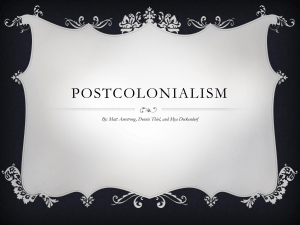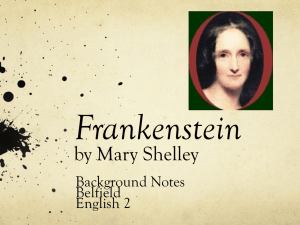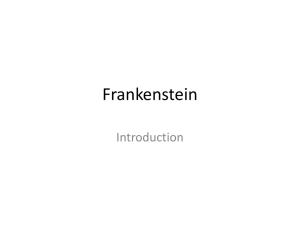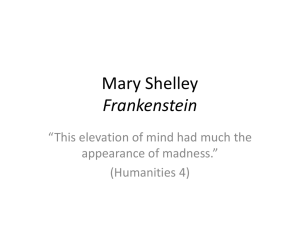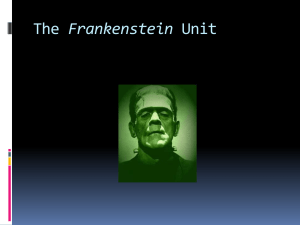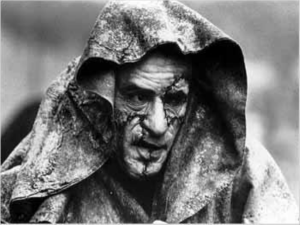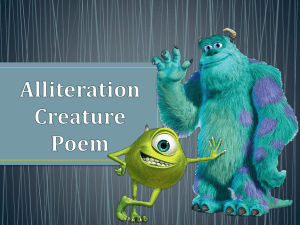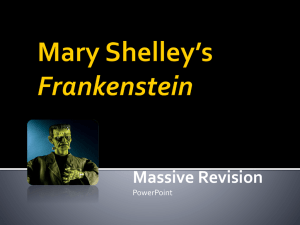Frankenstein - University Place School District
advertisement
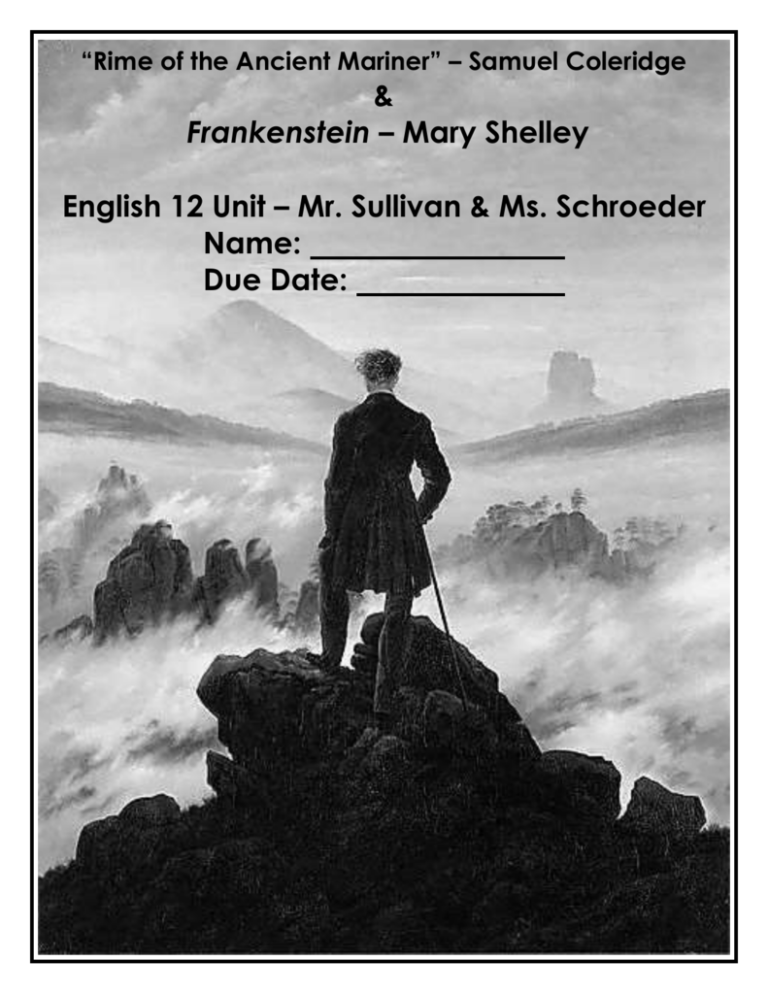
“Rime of the Ancient Mariner” – Samuel Coleridge & Frankenstein – Mary Shelley English 12 Unit – Mr. Sullivan & Ms. Schroeder Name: Due Date: February 2014 – English 12 “Rime…Mariner”– Sullivan & Schroeder January 27 Intro to class 2nd sem Notes on “Gothic Elements” January 28 Resume DUE (w/peer review sheet attached) Samuel Coleridge “Rime of the Ancient Mariner” pts I-IV HW: Read Coleridge Bio & Take notes Feb 3 (Resume returned) “Rime of the Ancient Mariner” Pts V-VII In-Depth ?s 4 from Paradise Lost – the fall of Lucifer + synopsis all of Paradise Lost HW: “Rime of the Ancient Mariner” - Reflection 10 (Resume returned) pg 29-46 A.R.?s DUE HW: Read Shelley Bio & author’s intro pgs. v-x 11 Pg 46-60 A.R.?s DUE January 29 January 30 Gleaming a Better Understanding Questions for Part I-IV 5 11:45 dism + Assemby Final Typed Resume DUE Frankenstein Intro Questions “Rime of the Ancient Mariner” Pts I-IV In-Depth ?s 6 Letters A.R.?s DUE In-depth discussion ?s on “The Letters” January 31 Samuel Coleridge “Rime of the Ancient Mariner” Pts V-VII HW: Down with Neoclassicism…. 7 pg14-29 A.R.?s DUE Walton Character Analysis HW: P. 1-14 & A.R. ?s HW: P.14-29 & A.R. ?s 12 – Cohort Day –Resume 13 Pg 76-97 A.R.?s DUE Pg 61-76 A.R.?s DUE Creature Character Prometheus story Analysis HW: P.29-46 & & A.R. ?s 14 Pg 97-114 A.R.?s DUE HW: P.46-60 & & A.R. ?s HW: P.61-76 & & A.R. ?s 17 Mid-Winter Break 18 Mid-Winter Break (NOTE: READING OVERLAPS 2 VOCAB & 3 HW: P. 76-97 & A.R. ?s 19 Mid-Winter Break A.R. SECTIONS. DO EACH HW: P. 97-114 & A.R. ?s 20 Mid-Winter Break ON SEPARATE SHEETS OF HW: P. 114-166 & AR?s 21 Mid-Winter Break PAPER!) HW: Read p. 114-166 & Active Reading ?s 24 Pg 114-166 A.R.?s DUE HW: Read p. 114-166 & Active Reading ?s 26 Ch 19-24 In-depth ?s DUE HW: Read p. 114-166 & Active Reading ?s 27 HW: Read p. 114-166 & Active Reading ?s 28 Victor Frankenstein: The Beginning Quiz pages 114-166 Review reading over break 3 Gothic Elements in Frankenstein In-depth discussion questions ch.1-8 HW: Read p. 114-166 & Active Reading ?s 25 In-depth discussion questions ch.19-24 Romantic Pictograph Victor, Walton & Creature Analysis In-depth discussion questions ch. 9-18 PACKETS DUE Vocab Test HW: Finish In-Depth ?s 4 Theme Analysis HW: FINISH Pictograph 5 Assign essay Due Thurs, March 13th Editing Day Tues, Mar 11 Intro to Les Misérables H.W. Study Vocab “Rime of the Ancient Mariner” & Frankenstein Unit In this packet you will find the calendar, daily active reading questions/responses and section analysis questions for the unit. You will be responsible for consulting the calendar to keep up with due dates for reading and for assignments. To supplement your understanding of the poem & novel, expect to be prepared to participate in daily discussion regarding particular motifs and themes throughout the unit. We will also have several other daily assignments to be done in class that are not included in this packet. Check calendar for those dates and be ready to come to class prepared to participate in these assignments. While this unit will undoubtedly cover plot and character analysis, we will be paying special attention to particular motifs presented by Samuel Coleridge & Mary Shelley in our quest to discover the many themes of the poem & the novel and the overall writer’s intent with each story. Within “Rime of the Ancient Mariner,” the motifs that we will be particularly looking for are: Use of supernatural Imagination vs Order, Control and Logic Nature/Natural Man vs “Civilized Man” Spiritual Growth Within Frankenstein the motifs that we will be particularly looking for all of the above PLUS: Nature vs Nurture Value of intellectual pursuits Value/place of science in society/world Treatment of the disenfranchised Pressures of the class system You will be expected to actively read & flag your text for evidence of the above motifs. This will be assessed daily. Overall requirements for this unit: Daily active reading flagging 1) Daily active reading questions & observations on above motifs (see active reading sections of packet) 2) Section analysis questions (see section analysis questions) 3) Daily class work as indicated by calendar 4) Final essay to be assigned on March 5th – due March 13th. Elements of Gothic Art Painting Architecture Literature Samuel Coleridge – Notes Born/died (include how): Occupations: Social Status: Focus of Romanticism: Major works: “Rime of the Ancient Mariner” Vocab Give definition, pg #, copy sentence from the piece and line #, create your own original sentence. averred– def: Pg# & Line: Original sentence: sere – def: Pg# & Line: Original sentence: wan– def: Pg# & Line: Original sentence: wont – def: Pg# & Line: Original sentence: corses – def: Pg# & Line: Original sentence: penance – def: Pg# & Line: Original sentence: seraph man – def: Pg# & Line: Original sentence: perforce – def: Pg# & Line: Original sentence: shrieve – def: Pg# & Line: Original sentence: smote – def: Pg# & Line: Original sentence: “Rime of the Ancient Mariner” – Active Reading Fill in the appropriate information as we read through the poem Part I Setting: Characters: Plot Summary: Main Conflict: Theme: Part II Setting: Characters: Plot Summary: Main Conflict: Theme: Part III Setting: Characters: Plot Summary: Main Conflict: Theme: Part IV Setting: Characters: Plot Summary: Main Conflict: Theme: Part V Setting: Characters: Plot Summary: Main Conflict: Theme: Part VI Setting: Characters: Plot Summary: Main Conflict: Theme: Part VII Setting: Characters: Plot Summary: Main Conflict: Theme: Part I-IV – Gleaning Better Understanding 1. Describe the mood conveyed by the “engraving” on page 815 of the text book. What details contribute to this mood? 2. Look at lines 63-78, what two good things happen after the albatross appears? 3. In lines 63-78, why does the crew welcome the albatross each day and offer it food? 4. Look at the “engraving” on page 817, in what way do the mariners’ facial expressions reflect their feelings toward the albatross? 5. Re-read lines 123-126, identifying examples of onomatopoeia. In what way do these words contribute to the mood of the scene? 6. What details from lines 79-82 suggest that the mariner has feelings of guilt about shooting the albatross? 7. Look at lines 149-180, what is the mariner’s reaction to the ship? 8. Again, in lines 149-180, why must the mariner bite his arm and suck the blood? What does this say about his overall condition at this point in his voyage? 9. In lines 185-198, Life-in-Death and Death gamble for possession of the mariner. What does the appearance of these two figures suggest about the mariner’s guilt and the severity of the crime? 10. Who is speaking in lines 224-225? Why does the speaker fear the ancient mariner? 11. In lines 224-239, what is the mariner’s reaction to being the only survivor of the tragic voyage? 12. Storytellers of traditional ballads often repeated words to help make their works memorable. What ideas in lines 232-235 does Coleridge want his readers to remember? 13. Within lines 248-256 suggest about the mariner’s feelings of guilt? What does this suggest about his overall character (at this point)? 14. Using the first four parts of this poem, create a general statement about the mariner’s developing comprehension of nature. Use specifics from the poem to support your statement. “Rime of the Ancient Mariner” – In-depth reflection With a partner or two, thoroughly discuss and answer the following reflective questions on Coleridge’s “Rime of the Ancient Mariner.” Understand that each of these questions could be full essay questions, so your responses should delve into the greater aspects of this poem. For the purpose of this assignment, it is not expected that you write an essay for each question, but it is expected that your responses show your ability to analyze and look deeply into the greater meaning of the poem and go well beyond plot summary. (Each of you will need to submit this sheet) 1) Coleridge first published several poems, including "The Rime of the Ancient Mariner" in Lyrical Ballads, (a book he shared publication of with William Wordsworth). In that work Coleridge’s task was to take unreal situations, supernatural situations, and somehow make them psychologically real. How does Coleridge take an unreal ghost story and make it express truths about human nature? 2) The story the Mariner tells is gripping and at some points frightening (especially for those who would have read it in its first publication). How does Coleridge use elements of the gothic to influence the poem? Down with Neoclassicism! Romanticism is Paramount! For the following elements of Romanticism (R) explain how Coleridge exalts them (uses them to prove his point) in “Rime of the Ancient Mariner.” For the following elements of Neoclassicism (N) explain how Coleridge shows them to be fallacies throughout the story in the poem. Changing/Diverse Universe (R) Imagination (in the writing & on the part of the character) (R) Nature/Natural Man Holding Truths of Life (R) Endless Potential for Spiritual Growth (R) Order/Symmetry (N) Calm/Control/ Restraint (N) Civilization/Civilized Man (N) A Very Brief Synopsis of Paradise Lost (Yes, it does sound like the biblical story of the beginnings of mankind) Each book of Paradise Lost is prefaced with an argument, or summary. These arguments were written by Milton and added because early readers had requested some sort of guide to the poem. Several of the books also begin with a prologue. The prologue to Book I states Milton’s purpose: to tell about the fall of man and justify God’s ways to man. The epic begins traditionally in medias res. Satan and the other rebellious angels awake to find themselves in Hell on a lake of fire. Satan is lying beside Beelzebub. Satan raises himself from the lake and flies to the shore. He calls for the other angels to do the same, and they assemble by the lake. Satan tells them that all is not lost and tries to inspire his followers. Led by Mammon and Mulciber, the fallen angels build their capital and palace, Pandemonium. The highest ranking of the angels then assemble for a council. In the council, Satan asks what the demons think should be the next move against God. Moloch argues for open warfare. Belial twists Moloch’s arguments, proposing that nothing should be done. Mammon, the materialistic angel, argues that they do the best with what they have. Finally, Beelzebub, Satan’s second in command, proposes that the angels try to get at God through his new creation, Man. Beelzebub’s proposal, which is really Satan’s proposal, is adopted, and Satan volunteers to find the new world and new creatures. He leaves at once, flying to the Gate of Hell. There, he meets his children, Sin and Death. Sin opens the gate for Satan who flies out into Chaos and Night. Sin and Death follow him. Finally, in the distance Satan sees Earth. God watches Satan approach Earth and predicts his success in corrupting Man. Man has free will. But God omnisciently knows what will happen. God adds that Man can be saved through mercy and grace, but he must also accept the just punishment of death, unless someone takes on death for Man. The Son offers to become a man and suffer death in order to overcome it. The angels rejoice. In the meantime, Satan, sitting on the edge of the Earth, cannot see the way to Man. Satan disguises himself as a cherub and flies to the sun to talk with the archangel, Uriel. Uriel shows Satan the way to Man. Looking at Earth, Satan is taken with its beauty but quickly overcomes his sympathy to concentrate on what he must do. He sees Adam and Eve and is entranced with their beauty. As Satan listens to the pair, they talk about God’s one commandment that they not eat from the Tree of Knowledge under penalty of death. Satan immediately begins to formulate a plan. Uriel, on the sun, becomes suspicious of the cherub whose face shows changing emotions and goes to warn Gabriel. Gabriel says that he and his angels will capture any interlopers in the Garden, and late that night Ithuriel and Zephron capture Satan whispering in Eve’s ear. The two angels bring Satan before Gabriel, who, with God’s help, banishes the tempter from Earth. When Eve awakes, she tells Adam of her troubling dream. Adam comforts her, reminding her that they are safe if they obey God. God decides to send the angel Raphael to warn Adam and Eve to be wary of Satan. Raphael goes to Earth where he eats with Adam and Eve. After the meal, Raphael tells Adam about the great rebellion in Heaven. Raphael says that Lucifer (Satan) was jealous of the Son and through sophistic argument got his followers, about one third of the angels, to follow him to the North. There, only one of Satan’s followers stood up against him—Abdiel, who returned to God. Satan attacks God and the Heavenly Host, whose power has been limited by God. Nonetheless, God’s forces have little difficulty in defeating the rebels. Michael splits Satan in half, which is humiliating, but not deadly, because Satan, as an angel, cannot die. After the first day of battle, the rebels construct a cannon and begin the second day’s battle with some success. God’s forces begin to pull up mountains and hurl them at the rebels, burying them and their cannons. God is amused at the presumption of the rebels but does not want the landscape destroyed. He sends the Son forth by himself in a chariot. The rebels are quickly herded into Hell. Next, Raphael responds to Adam’s questions about the creation of the world. The angel explains the day-by-day creation of the world in six days. Then, in an effort to keep the angel engaged in conversation, Adam asks about the motions of the heavenly bodies. Raphael explains that Adam should leave some questions to God’s wisdom. Next, Adam describes his own creation, his introduction to Eden, and the creation of Eve. He describes how beautiful Eve is to him and the bliss of wedded love. Raphael gives Adam a final warning about Satan as he leaves. Having been gone from Eden for eight days, Satan returns, sneaking in through a fountain near the Tree of Knowledge. He takes the form of a serpent to try to trick Man. When Adam and Eve awake, they argue over whether they should work together or alone. Eve finally convinces Adam to let her work by herself. Satan, in serpent’s form, approaches Eve and, using clever but fallacious arguments, convinces her to eat the fruit of the Tree of Knowledge. After Eve eats, she reveals what she has done to Adam, who, unable to bear the thought of losing Eve, eats also. Having eaten the fruit, the two are overcome with lust and run to the woods to make love. When they awake, they are filled with shame and guilt. Each blames the other. In Heaven, the angels are horrified that Man has fallen, but God assures them that He had foreknowledge of all that would happen. He sends the Son to Earth to pronounce judgment on the humans and the serpent. The Son goes to Earth and makes his judgments. He adds though, that through mercy, Adam and Eve and all humans may eventually be able to overcome death. In an act of pity, the Son clothes the two humans. Sin and Death meanwhile have sensed an opportunity on Earth. They construct a huge causeway from Hell to Earth. On their way across, they meet Satan returning to Hell. They proceed to Earth while Satan enters Hell in disguise. Satan appears on his throne and announces what he has done. Expecting to hear the applause of all the fallen angels, he instead hears only hissing as he and all his followers are turned into snakes. When they eat the fruit of the Tree of Knowledge which appears before them, it turns to bitter ashes. On Earth, Sin and Death see infinite opportunities. God, looking down on the two, says eventually they will be cast into Hell and sealed up. Adam and Eve lament, but Eve submissively asks Adam’s forgiveness. He relents, his love overcoming his bitterness. She suggests suicide as a way to avoid the terrible curse on the world, but Adam says they must obey God. God sends the angel, Michael, to take Adam and Eve out of Eden. Before doing so, Michael takes Adam to a hill and gives the human a vision of biblical history, ending with the birth of Jesus who will be the savior of Man. Adam rejoices. Adam and Eve together are led out of Eden. Behind them a flaming sword guards the entrance; ahead, they face a new life in a new world. Frankenstein Vocab & Background Info – Letters 1-4 BACKGROUND The Arctic When the novel opens, an explorer named Robert Walton is organizing an expedition through the Arctic, the area around and within the Arctic Circle and near the North Pole. The Arctic Ocean covers most of this region, and more than half of the ocean’s surface is frozen at all times. Travel by ship is extremely dangerous. Huge sheets of ice float through the frigid waters, threatening to crush the vessels that appear in their paths. Did You Know? In the letters, which set the stage for the novel, Robert Walton says he has been deeply affected by the narrative poem The Rime of the Ancient Mariner, written by Samuel Taylor Coleridge, a leading poet of the Romantic era. In the poem, an old sailor, or mariner, tells the story of a horrific sea voyage that changed his life. Sailing in stormy seas near the South Pole, the mariner’s ship is surrounded by ice. When the crewmen spot an albatross, a huge seagull-like bird, flying through the fog, the ice splits open, freeing the ship. Then, unexpectedly, the mariner shoots the albatross. After this act of cruelty, the ship is cursed. Driven north, it becomes stranded in a hot, windless sea. All of the crew except the mariner die. Ever since, the remorseful mariner has traveled the world to tell his story and to teach others to revere God’s creatures. Walton’s comments about “The Ancient Mariner” are examples of allusion. An allusion is a reference in a written work to something from history, art, religion, myth, or another work of literature. Writers use allusions to give readers additional insights about what is happening in the story and why. Shelley makes frequent use of literary allusions in Frankenstein. For each vocab word given, copy sentence from the piece with line and/or page # and create your own original sentence. ardent - adj. passionate Pg# & Line: Original sentence: countenance - n. face; expression Pg# & Line: Original sentence: dauntless - adj. fearless Pg# & Line: Original sentence: harrowing - adj. extremely distressing Pg# & Line: Original sentence: irrevocably - adv. in a way impossible to change Pg# & Line: Original sentence: mariner - n. navigator of a ship Pg# & Line: Original sentence: perseverance - n. steady persistence Pg# & Line: Original sentence: Frankenstein Active Reading – Pages 1-14 (“the letters”) ACTIVE READING QUESTIONS: Completely answer the following questions ON YOUR OWN PAPER. These are due when your calendar states the readings are due. Letter I - Letter II – Letter III – Letter IV – 1. 2. 3. 4. 5. 6. 7. 8. 9. 10. 11. 12. 13. 14. 15. Who is being written to? Where is the writer when the first letter is written? What is the writer’s goal? What “occupation” did the writer attempt and “failed”? How was his voyage financed & how long did it take to plan? Who is writing the letters? Where is the 2nd letter written from? What is the writer “missing” that he feels its absence as “a most severe evil”? What is the “master’s” history with a particular Russian female? The writer says that he is off to “the land of mist and snow” but that he will kill no albatross. What do you think he means by this in his situation? How is this letter to be “sent/delivered”? What is the situation of the ship at the beginning of this letter? What did the crew see when the mist first cleared? What was the condition of the man who boarded? How does the writer feel about the man who boarded? Reading Observation: Your Question: How does this section “comment” on one of the motifs? Frankenstein Vocab & Background Info – Chapters 1-10 BACKGROUND Two Well-Rounded Characters In Chapters 1 through 10, Shelley develops the two main characters in the novel: Victor Frankenstein and his creature. She also introduces a number of minor characters. Both Frankenstein and the creature have complex and multifaceted personalities. In this regard, they stand out from the other characters in the novel. When a fictional character has individuality and depth, and experiences personal growth or change, he or she is called a round character. The opposite of a round character is a flat character. Round characters are life-like and threedimensional, while flat characters seem more like cardboard figures or stereotypes, and are not as well developed. Did You Know? Victor Frankenstein develops an interest in science after reading about the “wild fancies” of several noted alchemists who lived 300 to 500 years before his lifetime. Alchemy was a field of philosophy that speculated about natural processes and often involved chemical experiments. Medieval alchemists believed they could find substances that would enable them to transform ordinary metals, such as lead, into gold or create a magical drink that would extend life and youth forever. While alchemy is not true science, the alchemists did make some scientific contributions. They discovered mineral acids and alcohol. They also invented types of laboratory equipment and procedures, which were later modified and used by scientists. For each vocab word given, copy sentence from the piece with line and/or page # and create your own original sentence. benevolent - adj. showing charity Pg# & Line: Original sentence: commiserate - v. to express sympathy Pg# & Line: Original sentence: consolation - n. something that eases sorrow or disappointment Pg# & Line: Original sentence: discern - v. to detect; to perceive Pg# & Line: Original sentence: fiend - n. evil spirit; devil Pg# & Line: Original sentence: hideous - adj. extremely ugly Pg# & Line: Original sentence: omen - n. a sign of future good or evil Pg# & Line: Original sentence: Frankenstein Active Reading – Pages 14-29 (ch 1-3) ACTIVE READING QUESTIONS: Completely answer the following questions ON YOUR OWN PAPER. These are due when your calendar states the readings are due. 1. 2. 3. 4. 5. 6. 7. 8. 9. 10. Where was the new man on the ship from (his family heritage)? Who were his parents? What does “penury” mean? Who is the word used to describe? What is the name of the little girl who was adopted by the answer to question #2? What is our story teller’s name? Who was our story teller’s best friend – other than the adopted girl? What type/area of education was the story teller’s main interest? How old was he when he was enrolled at the University of Ingolstadt? What happened to his family before leaving for the university? Which professor berates him for his study of Agrippa? And, to which professor does he become a “disciple.” Reading Observation: Your Question: How does this section “comment” on one of the motifs? Frankenstein Active Reading – Pages 29-46 (ch 4-6) ACTIVE READING QUESTIONS: Completely answer the following questions ON YOUR OWN PAPER. These are due when your calendar states the readings are due. 1. 2. 3. 4. How long does Victor stay away from Geneva studying at Ingolstadt? What kept Victor from returning home? What was he able to do in one of his experiments? How long did his study/experiments/work continue before seeing the “accomplishment of his toils”? What was Victor’s first response upon seeing the first signs of life in his creature? 5. 6. 7. 8. 9. What did Victor dream about that night? What did Victor do upon awakening? What is the verse Victor recalls? What is it referring to? Why had Clerval not join Frankenstein earlier? How long does Clerval attend Frankenstein during his illness? Reading Observation: Your Question: How does this section “comment” on one of the motifs? Frankenstein Active Reading – Pages 46-60 (ch 7-8) ACTIVE READING QUESTIONS: Completely answer the following questions ON YOUR OWN PAPER. These are due when your calendar states the readings are due. 1. 2. 3. 4. 5. 6. 7. 8. 9. 10. 11. Who is Justine? Explain fully. Who are Victor’s brothers? When was Victor Frankenstein scheduled to return home? What happened to Victor’s youngest brother? When does Victor arrive at Geneva? What does he do when he gets there/where does he go? What does he see in the storm? What is happening to Justine? Explain fully. Where do the Frankensteins go to “get away”? Who does Victor blame for all the tragedies? How have the events changed Elizabeth? How long had Victor been away at school? Reading Observation: Your Question: How does this section “comment” on one of the motifs? Frankenstein Active Reading – Pages 61-70 (ch 9-10) ACTIVE READING QUESTIONS: Completely answer the following questions ON YOUR OWN PAPER. These are due when your calendar states the readings are due. 1. 2. 3. 4. What seemed to “soothe” the weight upon Victor’s “spirit”? Where does Victor meet his creation? What is the creature’s reaction/request to Victor? Where does Victor follow his creature? Reading Observation: (Next Page) Reading Observation: Your Question: How does this section “comment” on one of the motifs? Frankenstein Vocab & Background Info – Chapters 11-16 BACKGROUND Did You Know? There are many definitions of tragedy. In literature, a tragedy is a story that ends in the downfall of its main character and arouses pity or fear in the reader. In general, tragedy also expresses a tragic view of life—the idea that a noble person inevitably brings on his or her suffering or death through some failure or error. As you continue to read Frankenstein, think about whether the novel fits this definition of a tragedy. A Fallen Angel Do these words sound familiar? “Did I request thee, Maker, from my clay / To mold me man? Did I solicit thee / From darkness to promote me?” This quotation appears on the title page of Mary Shelley’s Frankenstein. It could have been spoken by Frankenstein’s creature. In fact, the words come from John Milton’s poem Paradise Lost (1667) and are spoken by the character of Adam. This book-length poem is a retelling of the story of Adam and Eve from the Bible. An equally prominent character in the poem is Satan, the lord of evil. Milton depicts Satan as the chief angel of heaven who rebels against God and is cast into hell. To avenge himself, he tempts Adam and Eve to disobey God in the Garden of Eden. Near the end of Chapter 10 of Frankenstein, the creature confronts his creator. He compares himself not only to Adam but to “the fallen angel, whom thou drivest from joy for no misdeed.” In Chapters 11through 16, Shelley expands on this allusion to Paradise Lost, emphasizing the parallels between God and Satan in the poem, and Frankenstein and his creature in the novel. For each vocab word given, copy sentence from the piece with line and/or page # and create your own original sentence. conjecture - v. to guess using the available evidence Pg# & Line: Original sentence: disconsolate - adj. unable to be cheered up Pg# & Line: Original sentence: enigmatic - adj. puzzling Pg# & Line: Original sentence: flagrant - adj. highly offensive Pg# & Line: Original sentence: pensive - adj. deeply or dreamily thoughtful Pg# & Line: Original sentence: venerable - adj. worthy of respect or reverence Pg# & Line: Original sentence: vengeance - n. punishment inflicted in return for a wrong Pg# & Line: Original sentence: wantonly - adv. maliciously; without restraint Pg# & Line: Original sentence: Frankenstein Active Reading – Pages 70-90 (ch 11- 14) ACTIVE READING QUESTIONS: Completely answer the following questions ON YOUR OWN PAPER. These are due when your calendar states the readings are due. 1. 2. 3. 4. 5. 6. 7. 8. 9. 10. 11. 12. What were the first pleasures the creature describes? How was the creature treated by people? Where does the creature “settle” and what does he see there? Be specific. How does he creature know the people he’s watching “love”? How does he realize they are in “pain”? How does he help them? How did he creature learn language? Who comes to relieve Felix’s sorrow? How does the creature learn to read? How does the creature learn about social status? What were the names of the cottage dwellers? How did this family end up in this cottage? Reading Observation: Your Question: How does this section “comment” on one of the motifs? Frankenstein Active Reading – Pages 90-104 (ch 15-16) ACTIVE READING QUESTIONS: Completely answer the following questions ON YOUR OWN PAPER. These are due when your calendar states the readings are due. 1. What does the creature find in the woods? Be specific. 2. While reading these texts, what human characteristics ”rise” within the creature? What does he abhor? 3. What did the creature discover in the pocket of the clothes he took from Victor’s lab? 4. What happens when the creature decides to talk to the cottagers? Explain fully. 5. What do the DeLaceys decide to do? 6. What happened with the girl by the stream? Explain 7. What was the creature’s intention upon meeting William Frankenstein? 8. Why does he frame Justine? Reading Observation: Your Question: How does this section “comment” on one of the motifs? Frankenstein Vocab & Background Info – Chapters 17-21 BACKGROUND The British Isles The British Isles include two main islands, Great Britain and Ireland, as well as numerous smaller islands. They lie a relatively short distance off the coast of Europe and were once connected to the continent. Four groups of people call the islands home, the English, Scots, Welsh, and Irish. While the climate is uniformly maritime, consisting of mild winters, cool summers, and ample precipitation, the landforms vary from the mountains and rocky headlands of Scotland to the plains of Southeast England. Did You Know? Tales of horror create suspense by raising questions or uncertainties about the action in the reader’s mind. Sometimes we don’t know what will happen. As we read, we wonder who or what is responsible for the events that take place, or we wonder how the events came about. In other cases, the tragic outcome is known or strongly hinted at at the beginning of the story. As we read, the suspense comes from anticipating when the worst will occur or wondering if it can be prevented. Authors often increase the readers’ feeling of fear or dread through foreshadowing. They give hints that suggest or prepare the reader for a later event. Such hints, or foreshadowing, might take the form of a statement by a character, a mood established in the description of the setting, or the revelation of an important trait in one of the characters. For each vocab word given, copy sentence from the piece with line and/or page # and create your own original sentence. base - adj. mean-spirited Pg# & Line: Original sentence: inexorable - adj. unyielding Pg# & Line: Original sentence: insurmountable - adj. impossible to overcome Pg# & Line: Original sentence: irksome - adj. annoying Pg# & Line: Original sentence: listless - adj. lacking energy Pg# & Line: Original sentence: malicious - adj. deliberately harmful Pg# & Line: Original sentence: torpor - n. state of inactivity or apathy Pg# & Line: Original sentence: traverse - v. to travel across Pg# & Line: Original sentence: Frankenstein Active Reading – Pages 104-114 (ch 17-18) ACTIVE READING QUESTIONS: Completely answer the following questions ON YOUR OWN PAPER. These are due when your calendar states the readings are due. 1. 2. 3. 4. 5. 6. 7. 8. What does the creature want Victor to do? Why does the creature say he is malicious? What are some arguments the creature used to convince Victor to do your answer to #1? What are Victor’s arguments against? What is Victor’s decision? What does Victor’s father propose as a help to Victor’s melancholy? What does Victor want to do first? Who goes with Victor? Reading Observation: Your Question: How does this section “comment” on one of the motifs? Frankenstein Active Reading – Pages 114-136 (ch 19-21) ACTIVE READING QUESTIONS: Completely answer the following questions ON YOUR OWN PAPER. These are due when your calendar states the readings are due. 1. 2. 3. 4. 5. 6. 7. 8. 9. 10. 11. 12. Where are they at the beginning of the chapter? How long do they stay there? Where do they go next? Why? Where does Victor begin his “labours”? What is the condition of this place? While working, Victor takes a moment to contemplate. How long has it been since he brought life to the first creature? What does Victor fear the creatures will do in their exile? What does Victor do to then 2nd creature? Where does the creature promise to be? Upon arriving in Ireland, what does Frankenstein discover? How long is Victor sick from this? Who comes to care for Victor? How does Victor react to the presence of this person? Reading Observation: Your Question: How does this section “comment” on one of the motifs? Frankenstein Vocab & Background Info – Chapters 22-24 BACKGROUND Did You Know? Five years after Frankenstein was published, Mary Shelley saw the first dramatic production of her novel. She liked the actor’s portrayal of her creature. How well she might like the hundreds of interpretations since is interesting speculation. In the 1931 film Frankenstein, starring English actor Boris Karloff, the monster comes to life on an operating table after being zapped with electricity. Given a huge, squared-off skull and pale corpse-like skin, Karloff portrayed the monster as a gentle, almost childlike character. His interpretation struck a chord with audiences, especially young children, from whom he received much fan mail. In the 1995 film version of the novel, Mary Shelley’s Frankenstein, Robert De Niro, an actor known for his violent tough-guy roles, was cast as the creature. The director, Kenneth Branagh, explained, “I wanted a wise and intelligent and multifaceted Creature who could be angry and even funny at times, and who would have a sense of humor, however darkly ironic.” To develop the physical appearance of the creature, make-up artists did research in books from the early 1800s on surgery, skin disorders, and embalming. They wanted to find out what Frankenstein would have been able to achieve using the techniques and knowledge available at the time. The result is a gray, scarred, hulking, patchwork sort of man. Two Characters in One? Many people who have not read Shelley’s novel think that Frankenstein is the name of the creature, not the scientist who brought him to life. Careful readers of the novel, however, point out that this mistake has a certain symbolic truth. They see the two characters as doubles of each other, or two parts of a divided self. The idea of the double comes from German folklore and is known as the doppelgänger (“double goer”). The concept was based on the ancient belief that each living creature has an exact double who exists as a spirit or ghost. Many writers of horror stories have employed the idea of the double. For example, in Robert Louis Stevenson’s novella of double identity, The Strange Case of Dr. Jekyll and Mr. Hyde, a respectable doctor becomes a murderous stalker by night. For each vocab word given, copy sentence from the piece with line and/or page # and create your own original sentence. adversary - n. enemy; opponent Pg# & Line: Original sentence: consternation - n. state of confusion Pg# & Line: Original sentence: illustrious - adj. very distinguished Pg# & Line: Original sentence: omnipotent - adj. all-powerful Pg# & Line: Original sentence: pilgrimage - n. long journey for a spiritual purpose Pg# & Line: Original sentence: Frankenstein Active Reading – Pages 136-149 (ch 22 – 23) ACTIVE READING QUESTIONS: Completely answer the following questions ON YOUR OWN PAPER. These are due when your calendar states the readings are due. 1. 2. 3. 4. 5. 6. 7. 8. 9. As they travel home, how does Victor’s father begin to view Victor? In his letter from Elizabeth what does Elizabeth want to know? How does Victor answer? How is Elizabeth acting as the wedding nears/happens and they embark on their honeymoon? What is the first night of their honeymoon like? How does the creature enact his revenge? What happened to Victor’s father? What happens to Victor after your answer to #3? How does the magistrate respond to Victor? Reading Observation: Your Question: How does this section “comment” on one of the motifs? Frankenstein Active Reading – Pages 149-166 (ch 24) ACTIVE READING QUESTIONS: Completely answer the following questions ON YOUR OWN PAPER. These are due when your calendar states the readings are due. 1. 2. 3. 4. Where does Victor go before leaving Geneva for good? What is the creature satisfied with? How did Victor get to Walton’s ship? List the trip from Geneva to the boat? What does Victor ask of Walton? 5. What does Victor warn Walton about the creature? 6. Walton tells his sister that he really wants to know something from Frankenstein but that Frankenstein will not tell him. What is this? 7. What is Walton most sad about? 8. What is threatening Walton’s vessel? 9. What does Walton fear because of this? 10. What does Frankenstein say to Walton’s crew? 11. What does Walton decide to do? 12. What are Victor’s last words of “advice” to Walton? 13. According to the creature, why did he go after Elizabeth? 14. What has the creature really desired all along (although he never gets it)? 15. What are the creature’s plans as he leaves Walton’s vessel? Reading Observation: Your Question: How does this section “comment” on one of the motifs? Frankenstein – The opening chapters 1-8 Briefly review the assigned chapters so far. After doing this answer the following questions, using complete sentences. You may work with ONE partner. Analyzing Literature 1. Who is Elizabeth and how does Frankenstein feel about her? What does their relationship tell you about Frankenstein’s values and personality? (3 pts) 2. What is Frankenstein’s purpose in pursuing science and philosophy? How do you interpret Frankenstein’s initial response to the success of his experiment? For someone so engaged in his pursuit of knowledge and advancement, why does he react this way? (3 pts) 3. Frankenstein says, “I shunned my fellow creatures as if I had been guilty of a crime.” From your reading, give specific examples of Frankenstein’s isolation from others. What does this tell you about his personality and his goals? Explain. (5 pts) 4. How is Frankenstein affected by the knowledge that the creature may be responsible for the death of William? In Chapter 7, what statement suggests that he views the creature as part of himself? Do you agree with Frankenstein that he bears some responsibility for the death? Why? (5 pts) 5. What does Frankenstein think of the creature when he meets him in Chapter 10? Why does he decide to follow the creature and listen to his story? Explain? (4 pts) Personal Response 7. What do you think of Victor Frankenstein as a student and scientist? What do you admire or dislike about his goals? Explain. Use ALL the space provided! (10 pts) Extended Responses 8. Evaluate the character of Victor Frankenstein using evidence from Chapters 1 through 10 of the novel. Focus your discussion on the following questions as well as others that occurred to you as you were reading. For full credit, you must USE ALL THE SPACE PROVIDED!!!! (20 pts) • What can you infer about Frankenstein’s character from his close personal relationships? …his scientific project? In your opinion, is he an appealing person? • Do you think that Frankenstein went too far in his quest for knowledge? Did he have a good motive for his project? Did he have adequate knowledge to begin his project? Did he consider possible consequences of his actions? • How is Frankenstein affected by what happens after he abandons the creature? Why does he call himself the “true murderer” of William? Frankenstein – Chapters 9-18 Briefly review the assigned chapters so far. After doing this answer the following questions, using complete sentences. You may work with ONE partner. Analyzing Literature 1. How is Victor feeling now that William and Justine have died? Is he consolable? What does he turn to in order to find some peace? In terms of Romanticism, why is this appropriate? (4 pts) 2. What does Frankenstein think of the creature when he meets him in Chapter 10? Why does he decide to follow the creature and listen to his story? Explain? (3 pts) 3. Why is the creature drawn to the family in the cottage? What qualities of the family affect the creature? How does the family’s reaction to the creature affect his view of himself and the human race? (3 pts) 4. After reading Paradise Lost, why does the creature think he is like Adam in that book? Why does he think he is like Satan? What are the specific reasons that the creature gives for hating his creator? Which do you think is more accurate comparison? Why? (3 pts) 5. How does the creature cause the deaths of William and Justine? What does the murder of William tell the creature about himself? According to the creature, what can save him from doing evil? Do you agree? Why/why not? (3 pts) 6. What arguments does the creature use to persuade Frankenstein to make the female creature? Are the valid reasons? Explain. In your opinion, should Victor create a second creature that is female? (3pts) 7. How has Frankenstein’s decision affected Frankenstein’s mood and personal life? (3 pts) 8. Thus far, do you find the creature more or less sympathetic than the character of Victor Frankenstein? Explain. (3 pts) 9. How believable is the account of the creature’s education? Refer to the novel and your own experience in your answer. (3 pts) Personal Response 10. What questions would you like to ask the creature? (You must come up with at least 3 real, thoughtful questions.) (6 pts) 1) 2) 3) Literature and Writing 11. Now that you have heard the creature’s story, do you think he is justified in declaring an “everlasting war” against the human species and his creator? Debate this question with your partner and write down your and your partner’s points. For full credit, you will need to use all the space provided. (10 pts) Frankenstein – Chapters 19-24 Briefly review the assigned chapters so far. After doing this answer the following questions, using complete sentences. You may work with ONE partner. Analyzing Literature 1. What keeps Frankenstein from completing the second creature? (You need several reasons here) In your opinion, does Frankenstein make a good decision? Or should he have finished the creature? 2. How does Frankenstein become lost at sea? What happens when he lands in Ireland? Do the people have the right to suspect this man “from the sea”? How probable do you think this whole situation is? (3 pts) 3. Why does he call himself Henry Clerval’s murderer? Do you agree or disagree with this? Explain. (3 pts) 4. What happens to Elizabeth? What is ironic, or unexpected, about the creature’s revenge on Frankenstein? In your opinion, why does the creature direct his revenge to Frankenstein’s wedding? Is it effective? Explain. (3 pts) 5. How does Shelley show that Frankenstein and the creature are both obsessed with revenge? Does either of them win? Explain. (3 pts) 6. How sympathetic is the creature as he looks upon the dead body of his creator? Victor states that the creature is eloquent and persuasive but evil with a fiend-like malice. How does the creature appear to you in his final scene with Walton? (4 pts) 7. How do you think Frankenstein failed or erred as a human being? What traits or attributes, do you think, led to the creature’s fate? What compelled Frankenstein to pursue such endeavors? (4 pts) 8. Does Frankenstein’s story have any effect on Walton? If so, what? If not, why? (4 pts) Personal Response 11. Did the ending of the novel surprise you? Can you imagine a different ending to the novel? What would that different ending be? How it would it have “worked” in terms of the tone, mood and set up of the novel as a whole? (10 pts)
